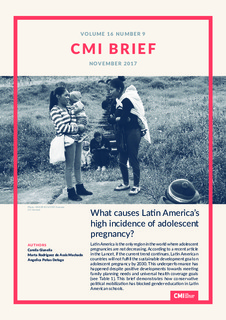What causes Latin America’s high incidence of adolescent pregnancy?
Report
Permanent lenke
http://hdl.handle.net/11250/2475446Utgivelsesdato
2017-11-01Metadata
Vis full innførselSamlinger
- Publications [1488]
Originalversjon
Bergen: Chr. Michelsen Institute (CMI Brief vol. 16 no. 9) 4 p.Sammendrag
Latin America is the only region in the world where adolescent pregnancies are not decreasing. According to a recent article in the Lancet, if the current trend continues, Latin American countries will not fulfill the sustainable development goal on adolescent pregnancy by 2030. This underperformance has happened despite positive developments towards meeting family planning needs and universal health coverage goals (see Table 1). This brief demonstrates how conservative political mobilization has blocked gender education in Latin American schools. Table 1: Latin American countries projected performance by 2030 on selected SDG indicators
Conservative mobilization through “gender ideology” The blockage of gender education in Latin American schools can have dramatic effects on the health and life projects of young people, especially on young women. The recent wave of blockages of initiatives designed to introduce gender related content in school curriculums shows that policies are not only decided based on scientific evidence. Despite research evidence of the critical role played by sex education and gender equality in preventing adolescent pregnancy, the implementation of such programs is challenged by conservative mobilization. This opposition has been especially heated in the last decade. The debates around educational plans and gender-related public policies have been framed as a fight against “gender ideology”. The use of “gender ideology” to discredit attempts towards gender equality is not a new phenomenon. During the International Conference on Population and Development in Cairo (ICPD) in 1994 and the Fourth World Conference on Women in Beijing in 1995, the Holy See strategically used gender ideology to present gender as a model imposed by liberals against the traditional family. Gender was portrayed as an artificial definition originating from “savage capitalism”, which aimed to destroy t
